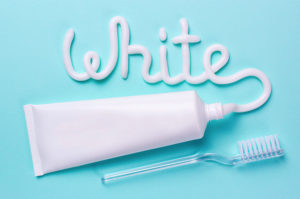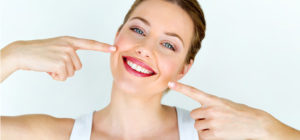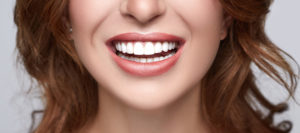Though our teeth naturally trend towards light yellow or light grey many Canadians want brighter smiles. However, as we age our teeth naturally darken, though surface stains caused by smoking and consuming select food and drinks can cause our teeth to darken more quickly than they normally would.
Our skin tone can also affect how white we perceive our teeth to be. Individuals with darker skin, or who wear a lot of dark makeup, tend to have teeth that appear brighter than paler individuals.
This demand for pearly white teeth has resulted in the development of a large variety of whitening products, which fall into two main categories: Surface whiteners and bleaches. Whitening products rely on time and concentration to work, and products that sit on your teeth for a longer period of time are more effective. This is part of the reason in-practice or in-office treatments are the most effective because they use more highly concentrated bleaching agents and are applied for a longer period of time than at home products.
Surface Whiteners

Whitening Toothpaste
All types of toothpaste contain mild abrasives to remove surface stains, but whitening toothpaste also typically contain chemicals or polishing agents to make them more effective stain removers. However, since whitening toothpaste does not contain bleach it is only able to remove surface stains. You should only ever use CDA approved toothpaste brands so that you can avoid choosing a toothpaste that is too abrasive and risk damaging your teeth.
Whitening toothpaste can whiten your teeth by about one shade, whereas in office whitening treatments can typically make your smile between three and eight shades lighter.
Brushing your teeth after every meal is an effective way to prevent surface stains from forming, and can help you keep your teeth white.
Bleaches

Whitening Gels and Strips
Whitening gels are peroxide based, clear gels that are applied directly to your teeth using a small brush. Whitening strips, such as Philip’s Zoom NiteWhite and DayWhite, are small, thin plastic strips coated with a peroxide whitening gel, which you apply to your teeth.
Both types of products contain bleaching agents, and you should be able to see results in a matter of days. Assuming your teeth do not become stained the whitening gel or strip results should last for about four months.
Whitening Rinses
Whitening rinses are a relatively new type of teeth whitening product. Like other mouthwashes, whitening rinses freshen your breath and help fight plaque buildup and gum disease. However, they also contain ingredients such as peroxide.
Most whitening rinses simply instruct you to swish with the rinse for one minute prior to brushing your teeth. Results can take up to twelve weeks to appear. However, because the whitening agents are only in contact with your teeth for about two minutes of every day (when you brush your teeth in the morning and again before bed) they have not been found to be particularly effective.
Tray-Based Teeth Whiteners
Tray-based whiteners can be purchased either over-the-counter or from your dentist. Tray-based systems involve filling a mouth-guard like tray with a gel whitening solution that contains peroxide. The tray is then worn in your mouth for anywhere between a few hours each day to overnight (depending on the product’s instructions). Daytime and overnight products use different concentrations of bleaching agents.
Nighttime products are less concentrated, so you can safely leave them on your teeth overnight while you sleep. Daytime products are more concentrated, so you don’t need to leave it on your teeth for as long in order to get the same results. Most users tend to prefer daytime products since they require less time and allow users to get on with their day to day activities. Also, at home tray-based teeth whiteners begin to lose effectiveness after about two hours of use because our saliva tends to dilute them beyond the two-hour mark, so overnight use products are typically less effective than daytime use products.
How long you need to wear the tray varies from product to product, and depends on the degree of discolouration and what sort of results you desire. However, most tray-based systems need to be worn for a minimum of four weeks.
In Office Whitening Treatments
In office whitening treatments, such as the Philips Zoom Whitespeed and the Philips Zoom Ultimate Protocol, are the quickest and most effective way to whiten your teeth. During an in-office bleaching, the whitening product is applied directly to your teeth and may be used in combination with heat, a laser, or a special light. You will typically see immediate results after your first thirty or sixty minute treatment. However, to achieve dramatic whitening results you will typically need to undergo several treatments.
In office whitening treatments are the most effective way to whiten your teeth for a variety of reasons. Over the counter whitening products typically only contain between 10% and 22% carbamide peroxide, whereas in office treatments typically contain between 15% and 43% carbamide peroxide. In office treatments also use custom fit mouth trays, which are able to allow the whitening gel more contact with your teeth than a one-size-fits-all tray. Custom made trays also ensure that there is minimal contact between your gums and the whitening gel. This is important because the whitening gel can irritate your gums, causing discomfort.
Your dentist is also able to put additional protective measures in place, such as a rubber shield that protects your gums and any cavities.
One of the main reasons in office whitening is more effective than at home treatments is the fact that your dentist can conduct a full oral exam and review your medical history, which can help you determine if bleaching is an appropriate course of treatment. The effectiveness of each type of bleaching treatment depends on the type and extent of the stains, and your dentist is able to determine which treatment would be most effective for you.
What to Expect (And What Not To Expect) When Whitening Your Teeth

It is important to have realistic expectations when it comes to teeth whitening. Individuals who are expecting their teeth to be blindingly white are likely to be disappointed with their results. How white your teeth become also depends on a variety of factors, including what you eat and drink. Coffee, red wine, and other foods and drinks can add new stains to your teeth and hamper your whitening efforts.
The natural colour of your teeth also dictates how effective whitening products can be. Teeth that are naturally yellowish typically respond well to bleaching, but teeth that are brownish tend to respond less well. Teeth with grey or purple hues may not respond to bleaching at all. Teeth that have been stained blueish-grey by the antibiotic tetracycline are more difficult to lighten and may require up to six months of at home treatments, or several in office treatments, before they lighten successfully.
Keeping Your Teeth White Naturally

Avoid Foods and Beverages That stain
One of the easiest ways to have white teeth is to keep them from accumulating stains. Avoiding foods such as wine, tea, and coffee can help prevent your teeth from becoming stained. If you choose to consume beverages that tend to stain teeth you may want to use a straw. You should also rinse your mouth after consuming foods and beverages that are likely to stain your teeth.
Avoid Sugar
You should also avoid consuming sugary drinks and candy. If you do consume sugary drinks, try and use a straw to keep them away from your teeth as much as possible. The bacteria that live on our teeth thrive on sugar, causing them to produce acid. This acid damages our tooth enamel, causing our teeth to become discoloured and encouraging cavities to form. After consuming sugary drinks or candy you should brush your teeth. Sticky or gummy candy is the hardest on our teeth since it tends to adhere to the tooth enamel, making it harder to remove. You should make a habit of flossing and brushing after eating sticky or gummy candy so you can be sure that the sugar is removed.
Good Oral Hygiene
Brushing your teeth after you eat, flossing your teeth to remove plaque, and rinsing your mouth with an antiseptic mouthwash are all ways that you can help prevent your teeth from becoming stained or discoloured.
Teeth Whitening and Tooth Sensitivity

The two most common side effects of tooth whitening products are tooth sensitivity and mild irritation of the soft tissues in your mouth, particularly your gums. Tooth sensitivity is most likely to occur during the early stages of a bleaching treatment, and tissue irritation is more likely to be caused by an ill-fitted mouthpiece tray than the bleaching agent itself. Both tooth sensitivity and tissue irritation are usually temporary and should stop within one to three days of stopping or completing your bleaching treatment.
If you do experience tooth sensitivity you can reduce or eliminate it by:
- Wearing your tray for shorter periods of time (for example, asking your dentist to do two thirty minute sessions instead of one sixty minute session).
- Pausing your treatment for two or three days to allow your teeth time to adjust.
- Asking your dentist or pharmacist about high fluoride containing product that can help you remineralize your teeth. Applying the fluoride product to your tray and wearing it for four minutes before and after your whitening treatment can help reduce or eliminate whitening related tooth sensitivity.
- Use a toothpaste designed for people with sensitive teeth. These types of toothpaste often contain potassium nitrate, which can sooth the nerve endings in your teeth.
Conclusion

Teeth whitening products can be a great way to keep your smile bright. However, different products offer different results and work on different timelines. You should make sure you are well informed about what results you can expect from each type of whitening product so you can manage your expectations accordingly.
Teeth whitening products are only able to lighten our natural tooth colour and remove stains that are already present. In order to prevent new stains from forming you should avoid consuming foods and drinks that stain your teeth. You should also brush your teeth after eating to remove fresh stains and protect your tooth enamel.
Teeth whitening is not suitable for everyone, so you should consult with your dentist before you begin any sort of teeth whitening regime.


